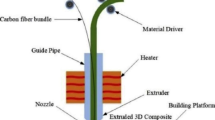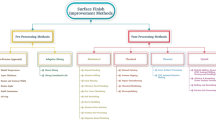Abstract
Fused Deposition Modelling is an additive manufacturing method that is gaining popularity to create complex parts. However, the printed product often suffers from poor surface finish. Although various chemical treatment methods have been proposed to enhance the surface finish quality of printed parts, the treatment mechanism and its effect on the mechanical properties of the parts have not been well identified and characterized. The focus of this study is to investigate the impact of chloroform solution concentrations and immersion times on the surface roughness, tensile strength, and impact strength of polylactic acid-printed parts after chemical dipping treatment. Additionally, it seeks to understand and characterise the mechanism through which chloroform affects surface properties and alters mechanical characteristics. For this purpose, a central composite design was used to design a set of 13 experiments with varying levels of concentration and immersion time. The mechanisms underlying the changes in surface roughness, tensile strength, and impact strength were evaluated using scanning electron microscopy and energy dispersive X-ray analyses to evaluate the topography and elemental composition of the treated surface. Thermogravimetric analysis and differential scanning calorimetry were employed to investigate the change in thermal properties and crystallinity. The results reveal a significant reduction in surface roughness on sloped and flat surfaces. Additionally, the treated specimen demonstrated higher impact strength, while a decrease in tensile strength was observed. In addition, structural and elemental compositional changes were noted to the outer surface layer of the specimens.























Similar content being viewed by others
Data availability
The data that support the findings of this study are available from the corresponding author, AAF, upon reasonable request.
Abbreviations
- FDM:
-
Fused deposition modelling
- PLA:
-
Polylactic acid
- CVS:
-
Cold vapor smoothing
- ABS:
-
Acrylonitrile butadiene styrene
- HVS:
-
Hot vapor smoothing
- ANOVA:
-
Analysis of variance
- SRI:
-
Surface roughness improvement (SRI)
- DCM:
-
Dichloromethane
- TGA:
-
Thermogravimetric analysis
- DSC:
-
Differential scanning calorimetry
- CCD:
-
Central composite deposit
- EDX:
-
Energy dispersive X-ray (EDX)
- FESEM:
-
Field emission scanning electron microscope
References
Di Angelo L, Di Stefano P, Marzola A (2017) Surface quality prediction in FDM additive manufacturing. Int J Adv Manuf Technol 93:3655–3662
Haque ME, Banerjee D, Mishra SB, Nanda BK (2019) A numerical approach to measure the surface roughness of FDM build part. Mater Today Proc 1(18):5523–5529
Kuczko W, Górski F, Wichniarek R, Buń P (2017) Influence of post-processing on the accuracy of fdm products. Adv Sci Technol Res J 11(2):172–179
Kumar P, Dwivedy SK, Banerjee S (2024) Fabrication and experimental characterizations of smart material filaments (SMFs) for possible future 4D-printing applications. Prog Addit Manuf 9(1):107–122
Nancharaiah TR, Raju DR, Raju VR (2010) An experimental investigation on surface quality and dimensional accuracy of FDM components. Int J Emerg Technol 1(2):106–111
Masood SH, Mau K, Song WQ (2010) Tensile properties of processed FDM polycarbonate material. Mater Sci Forum 654:2556–2559
Chohan JS, Singh R (2017) Pre and post processing techniques to improve surface characteristics of FDM parts: a state of art review and future applications. Rapid Prototyp J 23(3):495–513
Kechagias JD, Zaoutsos SP (2023) Optimising fused filament fabrication surface roughness for a dental implant. Mater Manuf Process 38(8):954–959
Kechagias JD, Zaoutsos SP (2023) An investigation of the effects of ironing parameters on the surface and compression properties of material extrusion components utilizing a hybrid-modeling experimental approach. Prog Addit Manuf 15:1–3
Fountas NA, Kitsakis K, Aslani KE, Kechagias JD, Vaxevanidis NM (2022) An experimental investigation of surface roughness in 3D-printed PLA items using design of experiments. Proc Inst Mech Eng Part J J Eng Tribol 236(10):1979–1984
Fountasa N, Kechagiasb J, Vaxevanidisa N (2023) Statistical modeling and optimization of surface roughness for PLA and PLA/Wood FDM fabricated items. J Mater Eng 1(1):38-44. https://doi.org/10.61552/JME.2023.01.005
Colpani A, Fiorentino A, Ceretti E (2019) Characterization of chemical surface finishing with cold acetone vapours on ABS parts fabricated by FDM. Prod Eng Res Devel 1(13):437–447
Garg A, Bhattacharya A, Batish A (2016) Chemical vapor treatment of ABS parts built by FDM: analysis of surface finish and mechanical strength. Int J Adv Manuf Technol 89(5–8):2175–2191
Nur S, Mazlan SN, Alkahari MR, Ramli F, Maidin N, Sudin MN, Zolkaply A (2018) Surface finish and mechanical properties of FDM part after blow cold vapor treatment. J Adv Res Fluid Mech Therm Sci 48:148–155
Jin Y, Wan Y, Liu Z (2017) Surface polish of PLA parts in FDM using dichloromethane vapour. MATEC Web Conf 95:05001
Zhang SU, Han J, Kang HW (2017) Temperature-dependent mechanical properties of ABS parts fabricated by fused deposition modeling and vapor smoothing. Int J Precis Eng Manuf 18:763–769
Lalehpour A, Janeteas C, Barari A (2018) Surface roughness of FDM parts after post-processing with acetone vapor bath smoothing process. Int J Adv Manuf Technol 95:1505–1520
Gao H, Kaweesa DV, Moore J, Meisel NA (2017) Investigating the impact of acetone vapor smoothing on the strength and elongation of printed ABS parts. JOM 69:580–585
Singh R, Singh S, Singh IP (2016) Effect of hot vapor smoothing process on surface hardness of fused deposition modeling parts. 3D Print Addit Manuf 3(2):128–133
Zhang SU, Han J, Kang HW, Shin BC (2017) Thermo-mechanical properties of ABS parts fabricated by fused deposition modeling and vapor smoothing. In: 2017 18th International Conference on Thermal, Mechanical and Multi-Physics Simulation and Experiments in Microelectronics and Microsystems (EuroSimE). IEEE. pp 1–6
Jayanth N, Senthil P, Prakash C (2018) Effect of chemical treatment on tensile strength and surface roughness of 3D-printed ABS using the FDM process. Virtual Phys Prototyp 13(3):155–163
He Y, Xue GH, Fu JZ (2014) Fabrication of low cost soft tissue prostheses with the desktop 3D printer. Sci Rep 4(1):6973
Kalyan K, Singh J, Phull GS, Soni S, Singh H, Kaur G (2018) Integration of FDM and vapor smoothing process: analyzing properties of fabricated ABS replicas. Mater Today Proc 5(14):27902–27911
Garg A, Bhattacharya A, Batish A (2016) On surface finish and dimensional accuracy of FDM parts after cold vapor treatment. Mater Manuf Process [Internet] 31(4):522–529
Lavecchia F, Guerra MG, Galantucci LM (2022) Chemical vapor treatment to improve surface finish of 3D printed polylactic acid (PLA) parts realized by fused filament fabrication. Prog Addit Manuf 7:65–75
Li B, Yang J, Gu H, Jiang J, Zhang J, Sun J (2021) Surface roughness of PLA parts by FDM with chemical treatment. J Phys Conf Ser 1948:012199
Prajapati M, Rimza S. An Experimental Study of Surface Improvement in FDM Parts by Va-por Treatment Process
Pearse A (2018) Chemical Smoothing of 3D Printed ABS. Master's thesis, Engineering and the Built Environment, Department of Mechanical Engineering. University of Cape Town. https://open.uct.ac.za/items/84deb5e2-2341-4bfa-a0a8-aebc1e8928aa
Hambali RH, Cheong KM, Azizan N (2017) Analysis of the influence of chemical treatment to the strength and surface roughness of FDM. In IOP Conf Ser Mater Sci Eng 210(1):012063. https://doi.org/10.1088/1757-899X/210/1/012063
Galantucci LM, Lavecchia F, Percoco G (2009) Experimental study aiming to enhance the surface finish of fused deposition modeled parts. CIRP Ann Manuf Technol 58(1):189–192
Percoco G, Lavecchia F, Galantucci LM (2012) Compressive properties of FDM rapid prototypes treated with a low cost chemical finishing. Res J Appl Sci Eng Technol 4(19):3838–3842
Valerga AP, Batista M, Fernandez-Vidal SR, Gamez AJ (2019) Impact of chemical post-processing in fused deposition modelling (FDM) on polylactic acid (PLA) surface quality and structure. Polymers 11(3):566
Mrowka M, Machoczek M, Szymiczek M, Gagol P, Duda S, Marcoll L (2020) Surface treatment of incrementally produced components in FFF (fused filament fabrication) technology. Polimery [Internet] 65(01):51–59
Valerga AP, Fernandez-Vidal SR, Girot F, Gamez AJ (2020) On the relationship between mechanical properties and crystallisation of chemically post-processed additive manufactured polylactic acid pieces. Polymers 12(4):941
Pérez M, Medina-Sánchez G, García-Collado A, Gupta M, Carou D (2018) Surface quality enhancement of fused deposition modeling (FDM) printed samples based on the selection of critical printing parameters. Materials 11(8):1382
Vasilescu MD, Fleser T (2018) Influence of technological parameters on the dimension of GEAR parts generated with PLA matherial by FDM 3D printing. Mat Plast 1(55):247–251
You DH (2016) Optimal printing conditions of PLA printing material for 3D printer. Trans Korean Inst Electr Eng 65(5):825–830
Chieng BW, Ibrahim NA, Then YY, Loo YY (2014) Epoxidized vegetable oils plasticized poly (lactic acid) biocomposites: mechanical, thermal and morphology properties. Molecules 19(10):16024–16038
Lima JC, Araújo EA, Agrawal P, Mélo TJ (2019) PLA/SEBS bioblends: influence of SEBS content and of thermal treatment on the impact strength and morphology. In: Macromolecular Symposia 383(1):1700072).
Perego G, Cella GD, Bastioli C (1996) Effect of molecular weight and crystallinity on poly (lactic acid) mechanical properties. J Appl Polym Sci 59(1):37–43
Acknowledgements
This work was supported in part by the Department of Mechanical, Materials and Manufacturing Engineering, University of Nottingham Malaysia, and Ministry of Higher Education (MOHE) Malaysia under the Fundamental Research Grant Scheme (FRGS) FRGS/1/2020/TK0/UNIM/02/16.
Funding
This study was funded by the Ministry of Higher Education (MOHE) Malaysia under the Fundamental Research Grant Scheme (FRGS) FRGS/1/2020/TK0/UNIM/02/16.
Author information
Authors and Affiliations
Corresponding author
Ethics declarations
Conflict of interest
On behalf of all authors, the corresponding author states that there is no conflict of interest.
Additional information
Publisher's Note
Springer Nature remains neutral with regard to jurisdictional claims in published maps and institutional affiliations.
Rights and permissions
Springer Nature or its licensor (e.g. a society or other partner) holds exclusive rights to this article under a publishing agreement with the author(s) or other rightsholder(s); author self-archiving of the accepted manuscript version of this article is solely governed by the terms of such publishing agreement and applicable law.
About this article
Cite this article
Akhavan Farid, A., Tshai, K., Jim, Z. et al. Surface finish enhancement in fused deposition modeling of PLA using chloroform: a comprehensive characterization study. Prog Addit Manuf (2024). https://doi.org/10.1007/s40964-024-00649-2
Received:
Accepted:
Published:
DOI: https://doi.org/10.1007/s40964-024-00649-2




